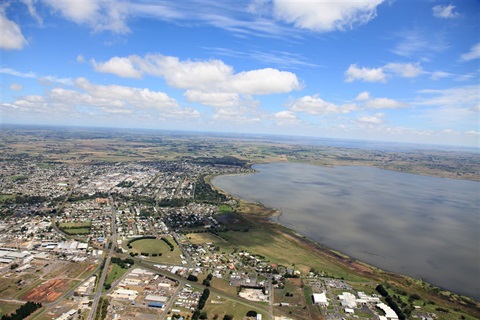New stormwater strategy critical to Colac’s growth
Published on 26 July 2018

New stormwater strategy critical to Colac’s growth
Nearly $15 million is needed to combat six flood prone hotspots in Colac and developers will need to fund most of the $70 million worth of waterway corridors and wetlands needed to provide for the city’s future growth.
The projected costs are part of the Colac Stormwater Development Strategy endorsed for public exhibition on Wednesday’s Ordinary Council meeting ahead of Councillors subsequent endorsement of the Colac 2050 Growth Plan and Planning Scheme Amendment.
Mayor Joe McCracken said the stormwater plan was vital to the Colac 2050 Growth Plan and its development had provided a new understanding of Colac drainage challenges.
“This strategy is partly about our current challenges that require mitigation works and partly about paving the way for appropriate and planned development of land in, and close to, Colac over the next 30 years,” he said.
“Prior to the development of this strategy, the Council’s knowledge of the overall performance of the existing drainage catchments in Colac was limited.
“Through this project, the city was hydraulically assessed to find out what storm events it could and could not handle.”
Cr McCracken said the detailed strategy identified a series of structural and non-structural measures to improve the management and performance of the drainage system.
“It has been identified that we need to consider budgeting $15 million over the next 20 years to address the highest priority problem areas in Douglas Street, Gravesend Street, Wilson Street, Lawrence Court and Mahoney Court,” he said.
“These locations are within six identified hotspots and further investigation and planning will be required – including community consultation – before we can move to a design and implementation phase.”
Cr McCracken said the strategy also recommended further work be undertaken as to whether Special Building Overlays should be introduced to complement existing Flood Overlays and the proposed Amendment C90.
“The other key recommendations are the need for man-made open drains, or waterway corridors, through proposed development areas as well as stormwater treatment wetlands to not only remove pollutants, but provide habitat, green space and assist the public amenity,” he said.
“The cost of these waterway corridors and stormwater wetlands would mostly be borne by the developers of these areas through infrastructure contributions like those associated with any rezoning that occurs.
“I encourage anyone interested in Colac’s existing and future stormwater management to consider making a submission during the six-week exhibition period beginning in August.”